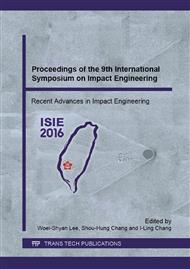p.3
p.13
p.23
p.27
p.33
p.39
p.43
p.48
Experimental Techniques and Measurements in Impact Engineering Using Hopkinson Bar Technique
Abstract:
In the paper, experimental analysis of dynamic plastic behaviour of different structural materials at high and very high strain rates up to 105 s-1 in various modes at lowered, room and elevated temperatures, is presented. The paper describes laboratory set ups for testing material specimens, based on various modifications of the Hopkinson bar technique. The paper focuses the attention on experimental tests and their interpretation. The results reported here will be useful for the designers working on the dynamic behaviour of building and mechanical protective structures made of different materials such as steels, aluminium alloys, ceramic and sand bricks, mortars, woods (pine, birch and aspen), ceramics and concrete fireproof and soils (sand, clay and sandy soil clay).
Info:
Periodical:
Pages:
3-12
Citation:
Online since:
September 2016
Authors:
Keywords:
Price:
Сopyright:
© 2016 Trans Tech Publications Ltd. All Rights Reserved
Share:
Citation:


